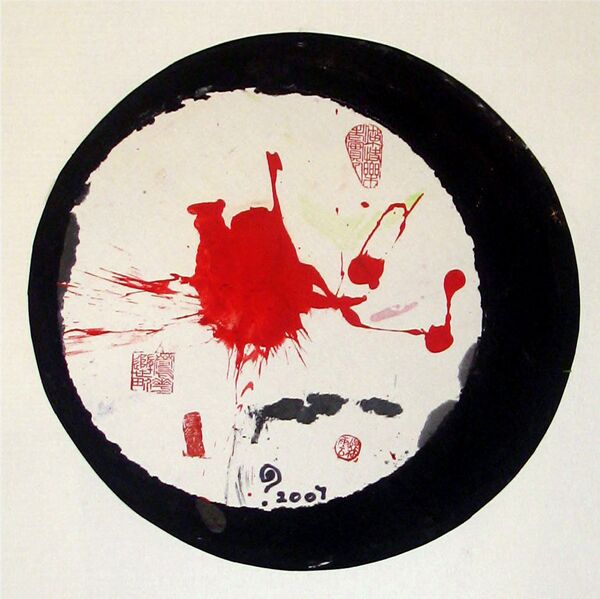News
Irene Chou (1924-2011)


Irene Chou (Zhou Luyun), one of the most influential artists of the New Ink Painting movement in Hong Kong, passed away July 1, 2011 at the age of 87. Chou was a student of Lui Shou-Kwan, New Ink Painting’s initiator, and a founding member of the two leading collectives—the In Tao Art Association (Yuan Dao huahui) and the One Art Group (Yi huahui). Chou’s innovations in ink art—in particular from her experimental period of the 1970s as she was developing her own style—opened up creative avenues for local avant-gardes who sought an indigenous Hong Kong art form.
Born in Shanghai, China on January 31, 1924, Irene Chou studied economics at St. John’s University, Shanghai. Upon graduating in 1945, Chou worked as a journalist for Peace Daily Shanghai until she and her husband left for Taipei, Taiwan, and later for Hong Kong in 1949.
While living in Hong Kong, Chou began to learn painting formally in 1954 when she became a student of Zhao Shao'ang, a master of the traditional Lingnan school of painting. Her paintings during her tutelage under Zhao in the 1950s and 1960s faithfully imitated her teacher’s work, as well as those of Song and Yuan masters. She mimicked her teacher so well, in fact, that Zhao was known to present Chou’s works as his own. Her traditional landscape and bird-and-flower paintings demonstrated Chou’s solid grounding in traditional Chinese painting methods such as qiyun (spirit-resonance) and moqi (ink-play).
In the late 1960s, Chou met the modern artist Lui Shou-Kwan who introduced western art concepts such as abstract expressionism in his ink paintings. His progressive theories on art and ink painting inspired her to move away from the popular Lingnan style and experiment with different techniques and various types of paint, including oil, acrylic and watercolor. Drawing influences from the dramatic and bold- colored Xichu New Year paintings (Chinese opera folk paintings) and expressive Great Seal Style calligraphy, Chou began to experiment in the 1970s with “splash ink” technique, densely layered “piled ink” technique, and pointillism—later she would introduce the high impact quality of Zen- and Tao-derived “one-stroke” (Yibi hua) technique to her dynamic, abstract paintings—elements that would define her signature style of the 1980s. Her works of the 1980s were representative of the New Ink style emerging in Hong Kong. Artists working in this vein followed Lui’s precepts and combined Western and Chinese art, while striving to retain the essence of Chinese traditional art.
A temporary gloom overcasts Chou’s works from the late 1970s. With the death of her mentor Lui Shou-Kwan in 1975 and that of her husband in 1978, Chou entered the darkest phase in her life. A painting from that period, Remembering Mr. Lui (year unknown), resembles a world within a world. An embryonic sphere, its surface overrun with intertwining tendrils, envelops one such other and floats within a dense ink wash. The interstitial void gives way to a horizon of more veinous growths, and embedded therein a single red dot appears, like a fragile point of consciousness, out of the ominous tumult of Chou’s universe.
Depression gave way to the bombastic energy of her most prolific period in the 1980s. Throwing herself into her painting, Chou’s style became bolder and more spontaneous. In these mature works, Chou began each with a visually jarring brush mark, and then laboriously painted around the mark until an entire vision was complete. A sense of primeval birth and cosmic vision pervades her works; a massive pressure is released through her intuitive execution style and compositional approach. Chou won a number of awards in the 1980s and came to be recognized as a key figure in the contemporary Hong Kong art scene—the Urban Council Fine Arts Award in 1983, and the Artist of the Year Award by Hong Kong Artists’ Guild in 1988. She participated in the Contemporary Hong Kong Art Biennial in 1983, 1985 and 1992.
In 1991, the 67-year-old artist suffered a life-threatening stroke. After intensive physiotherapy, she moved from Hong Kong to be near her son in Brisbane, Australia. A melancholy returned to her work of the 1990s and spurred a new round of innovations. Chou became increasingly obsessed with the idea of rebirth. Atop a moody, blackened background, shapes approximating the uterus and the fetus along with sprouting roots made frequent appearances in her work. An example of this trend is her mixed-media painting Circles Upon Circles (1995).
However, by the turn of the century, influenced in part by Australian Aboriginal paintings and by her belated interest in Buddhism, Chou’s work had become noticeably freer and light-hearted, characterized by relaxed brush strokes and bright, contrasting colors. In her twilight years, Chou had reached a state of equanimity. Speaking on her 2007 exhibition at iPRECIATION gallery, Hong Kong, “Life is a many splendored thing,” Chou said of her paintings: “They're about life and joy. They're about the portrayals of life's many beautiful and splendid elements and moments… They show that life is happier now.”
As a prominent figure in the New Ink Painting Movement, Irene Chou embodied the artistic trend to reimagine traditional ink painting as a contemporary art form. While playing a formative role in the development of modern Hong Kong art, Chou’s contribution to ink painting has also made a regional and international impact. In the last decade, modern ink painting has gained popularity in China, Taiwan and overseas, leading to the emergence of new artistic developments. Irene Chou’s passing is a great loss to both Hong Kong and the global art world.







